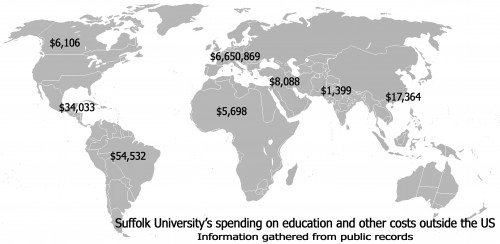Suffolk University not only accepts international students to study at its Boston campus, but also sends local students across the globe to study abroad.
In addition to Suffolk’s Madrid campus, the university sends students to dozens of other universities across the world. A quick scan of Suffolk’s website will show programs for students seeking an education abroad offered from Denmark, to Hong Kong, to Mexico, to Turkey.
And of course, this comes with a cost.
Students who study abroad pay Suffolk University’s tuition costs, according to information on Suffolk’s website.
So then, what does Suffolk spend on those programs abroad?
The university spends a grand total of $9,471,354 on “activities outside the United States,” according to public documents that represent the fiscal year July 2012 to June 2013. Costs are distributed between study abroad courses, recruiting, sending “agents” to seminars, grants and other costs. The document reports spending on programs it identifies as being in Europe, Asia and the Pacific, the Middle East and North Africa, sub-Saharan Africa, North America, Russia, South America, and Central America.
When asked about the university’s spending across the globe, a Suffolk spokesman said in a prepared statement, “On Schedule F, Part I, Column E of the FY 13 Form 990, there are three categories of expenses listed: Education, Recruiting, and Education & Other. These three categories include expenses associated with the university’s Madrid campus, international student recruitment, study abroad programs, as well as expenses associated with research conducted abroad.”
In Europe alone, Suffolk spends $5,425,628 on just education. The school pays an additional $1,225,241 on “education and other” costs in Europe as well.
On costs designated as education and other, Suffolk spends $34,033 in Central America and the Caribbean; $17,364 in East Asia and the Pacific; $8,088 in the Middle East and North Africa; $6,106 in North America; $54,532 in South America; $1,399 in South Asia; and $5,698 in sub-Saharan Africa.
The university also spends money in those areas for recruiting, according to the document. Suffolk spent $100,551 in Europe; $9,530 in Central America and the Caribbean; $10,819 in East Asia and the Pacific; $14,588 in the Middle East and North Africa; $11,045 in North America; $17,329 in South America; and $19,902 in South Asia.
Suffolk also spends money internationally sending “agents” to seminars. According to the document, the school spent the following amounts on those costs: $51,378 in Europe; $9,457 in Central America and the Caribbean; $1,907 in the Middle East and North Africa; $9,621 in North America; $5,533 in South America; $2,861 in South Asia; and $1,156 in sub-Saharan Africa.
Suffolk did not have any education or recruitment costs in Russia, but did spend $983 sending agents to a seminar there.
Though Suffolk spends millions on education and recruitment abroad, other colleges and universities in the area spend far more.
According to their respective 990 tax forms for the fiscal year July 2012 to June 2013, spending for activities abroad amounted to $1,076,024 at Harvard University; $25,524,181 at Emerson College; $140,146,095 at Northeastern University; $439,848,941 at Boston University; and $1,713,817,579 at the Massachusetts Institute of Technology.
In addition to the Suffolk’s Madrid campus, the university at one time had a campus in Dakar, Senegal. The Dakar campus was closed in 2011 after 12 years of offering classes. The 990 tax form for July 2010 to June 2011 reports that the university spent more than $11 million on international costs while the campus was still open.














